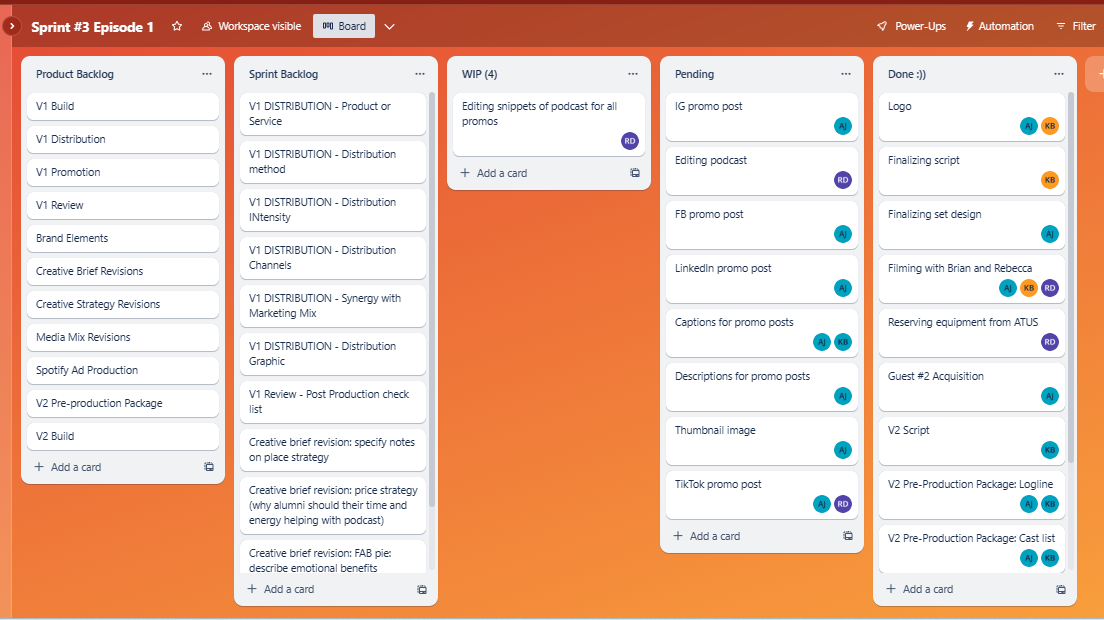With my last quarter as an undergraduate at Western Washington University coming to an end, it is only appropriate to reflect back on the most influential Marketing class I have been a part of. Integrated Marketing Communications and Applied Integrated Marketing Communications taught me so much about being a marketer, being a reliable teammate, and being a leader, all of which stemmed from the implementation of the agile marketing methodology.
Agile Marketing Manifesto takes a real-world approach to the creative process by focusing on outcomes over outputs, which allows for teams to work more efficiently without placing limitations upon the creative process necessary for content creation. Adjusting to the agile work flow came with many challenges for me when I was first introduced to the concept as a content creator as I always took on the leadership position in group settings and insisted on having control over whatever was being produced.
One of the most important lessons I have taken from using the agile process and running a marketing campaign is the power of collaboration and communication. As a Product Manager I saw myself in one of my Content Creators who also struggled with this transition of placing collaboration at the forefront of all progress. They came into the ideation stage of the media production cycle set on an idea for the Podcast, and it was difficult for them to understand that all members needed to take part in the ideation stage while simultaneously proposing a solution to the problems stated within the Creative Brief.
It is so easy to hyperfocus on your own ideas, but taking part in the agile process allows for everyone’s ideas to be heard and implemented. One of the things I like the most about agile, are the agile-activities that work to stimulate collaboration. When groups are asked to collaborate it is common for people to start sharing their ideas out loud, which often times translates to one person dominating the conversation which can limit the involvement of other members and does not encourage collaboration. I saw this as a Product Manager when I was leading my team through a sprint retro meeting, in which we discussed what went well during the Sprint, what did not go well, and actions to improve. During the meeting I first asked my team, “What went well?” to which they shared a few things, then when I asked them what did not go well there was silence. This may have been from fear of offending me as their Product Manager, not wanting to say the wrong thing, social anxiety, etc. but I knew as their PM that I needed to provoke this ideas in order to continue along with the agile process as we work to improve our product with each work cycle. That is when I followed the same ideation process as demonstrated in class and had all team members work independently to answer each prompt and then stick them on the white board, then collaborate with everyone.
When I first opened the discussion there was very little shared, yet after allowing each person time to contribute each person had five plus things to contribute to the board.
Organization is another influential lesson I have taken from my time implementing the agile process as both a Content Creator and a Product Manager. Before taking IMC I considered myself to be a very organized individual, but since being introduced to agile I have since become more organized than ever. Life before agile was full of to-do lists, and I have now made the full transition to Kanban boards, which is a visual board which utilizes a work break down structure to visually categorize stages of work. A Kanban, unlike a traditional to-do lists, takes large deliverables and breaks them down into smaller tasks that allows for all members to see the workflow process and visually see bottlenecks. An important aspect of the Agile Approach is the ability to inspect and adapt, and Kanban boards allow for Teams to visually see the contribution of other team members and the flow of work. Below are some examples of the Kanban boards my team and I used during my time as a Product Manager, in which we produced the fourth season of the Marketing by the Minute Podcast.

Being a Content Creator and Product Manager taught me so much about marketing and the Agile Methodology, but I know there is still so much to learn. By adopting the agile process I was able to successfully lead a team of three other undergraduate students produce, distribute, and promote the fourth season of Marketing by the Minute: Breaking Barriers. Despite being limited to just ten weeks we were able to produce three episodes that featured three WWU marketing alumni and three current WWU students, with the goal of highlighting the voices of diverse individuals within the marketing field. I will never forget my time as a Product Manager and I am so grateful to have learned so much within such a short amount of time.

